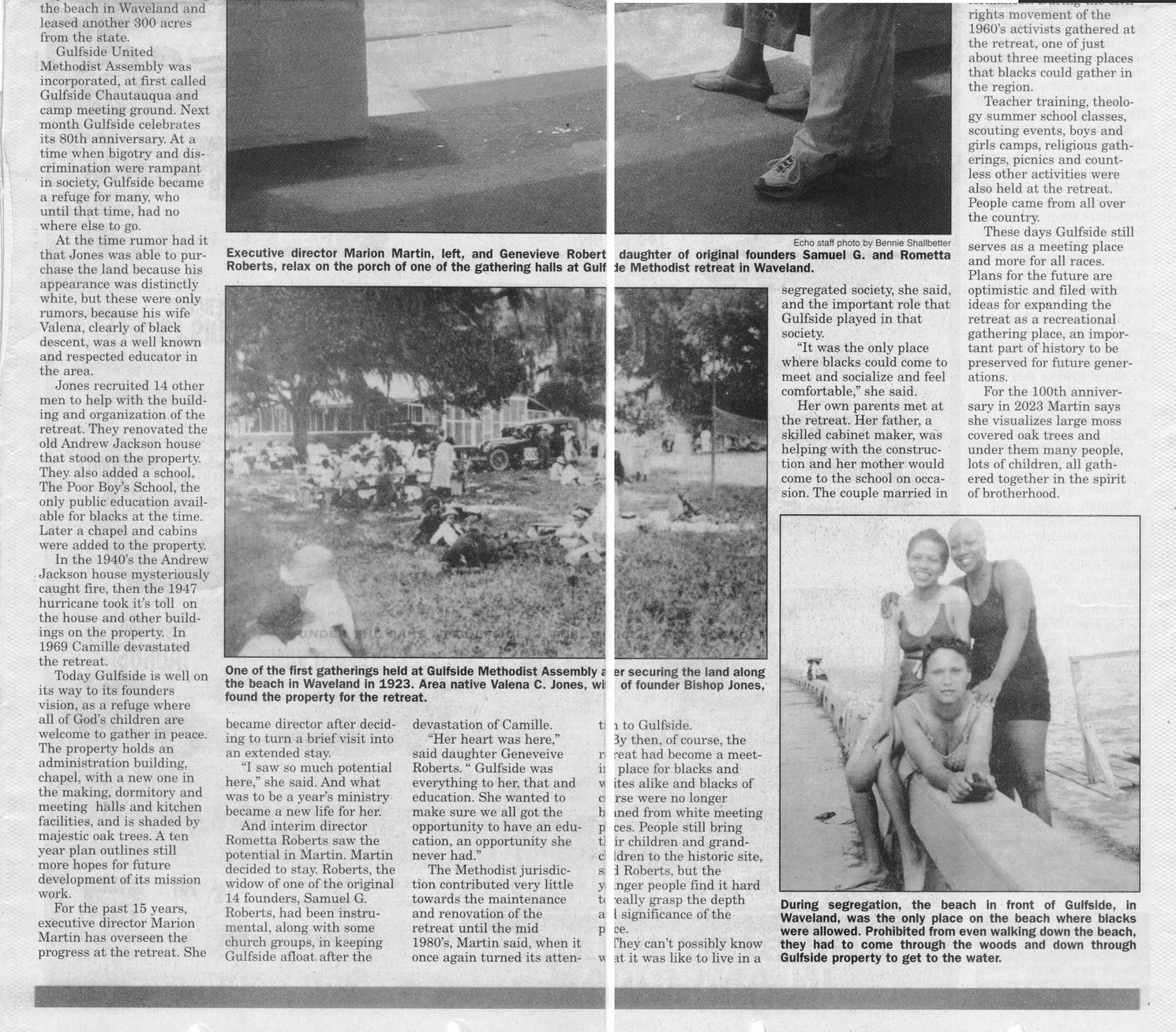This text was obtained via automated optical character recognition.
It has not been edited and may therefore contain several errors.
the beach in Waveland and leased another 300 acres from the state. Gulfside United Methodist Assembly was incorporated, at first called Gulfside Chautauqua and camp meeting ground. Next month Gulfside celebrates its 80th anniversary. At a time when bigotry and discrimination were rampant in society, Gulfside became a refuge for many, who until that time, had no where else to go. At the time rumor had it that Jones was able to purchase the land because his appearance was distinctly white, but these were only rumors, because his wife Valena, clearly of black descent, was a well known and respected educator in the area. Jones recruited 14 other men to help with the building and organization of the retreat. They renovated the old Andrew Jackson house that stood on the property. They, also added a school, The Poor Boy’s School, the only public education available for blacks at the time. Later a chapel and cabins were added to the property. In the 1940’s the Andrew Jackson house mysteriously caught fire, then the 1947 hurricane took it’s toll on the house and other buildings on the property. In 1969 Camille devastated the retreat. Today Gulfside is well on its way to its founders vision, as a refuge where all of God’s children are welcome to gather in peace. The property holds an administration building, chapel, with a new’ one in the making, dormitory and meeting halls and kitchen facilities, and is shaded by majestic oak trees. A ten year plan outlines still more hopes for future development of its mission work. For the past 15 years, executive director Marion Martin has overseen the progress at the retreat. She Executive director Marion Martin, left, and Genevieve Robert Roberts, relax on the porch of one of the gathering halls at Gulf Echo staff photo by Bennie Shallbetter daughter of original founders Samuel G. and Rometta Je Methodist retreat in Waveland. segregated society, she said, and the important role that Gulfside played in that society. “It was the only place where blacks could come to meet and socialize and feel comfortable,” she said. Her own parents met at the retreat. Her father, a skilled cabinet maker, was helping with the construction and her mother would come to the school on occasion. The couple married in rights movement of the 1960’s activists gathered at the retreat, one of just about three meeting places that blacks could gather in the region. Teacher training, theology summer school classes, scouting events, boys and girls camps, religious gatherings, picnics and countless other activities were also held at the retreat. People came from all over the country. These days Gulfside still serves as a meeting place and more for all races. Plans for the future are optimistic and filed with ideas for expanding the retreat as a recreational gathering place, an important part of history to be preserved for future generations. For the 100th anniversary in 2023 Martin says she visualizes large moss covered oak trees and under them many people, lots of children, all gathered together in the spirit of brotherhood. t v ■% > I * * j J., . i.-P ... . • -1 n; One of the first gatherings held at Gulfside Methodist Assembly £ the beach in Waveland in 1923. Area native Valena C. Jones, wi found the property for the retreat. became director after deciding to turn a brief visit into an extended stay. “I saw so much potential here ” she said. And what was to be a year’s ministry became a new life for her. And interim director Rometta Roberts saw the potential in Martin. Martin decided to stay. Roberts, the widow of one of the original 14 founders, Samuel G. Roberts, had been instrumental, along with some church groups, in keeping Gulfside afloat, after the devastation of Camille. ti “Her heart was here,” said daughter Geneveive r Roberts. “ Gulfside was ii everything to her, that and v education. She wanted to c make sure we all got the b opportunity to have an edu- p cation, an opportunity she t never had.” c The Methodist jurisdic- s tion contributed very little y towards the maintenance t< and renovation of the a retreat until the mid p 1980’s, Martin said, when it once again turned its atten- w er securing the land along of founder Bishop Jones, l to Gulfside. 3y then, of course, the reat had become a meet-place for blacks and ites alike and blacks of rse were no longer med from white meeting ces. People still bring ir children and grand-Idren to the historic site, i Roberts, but the nger people find it hard eally grasp the depth I significance of the ce. They can’t possibly know at it wras like to live in a During segregation, the beach in front of Gulfside, in Waveland, was the only place on the beach where blacks were allowed. Prohibited from even walking down the beach, they had to come through the woods and down through Gulfside property to get to the water.

Gulfside Methodist Assembly Bridging-the-Gulf-7-20-03-(2)